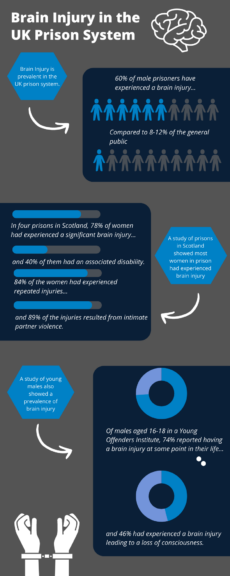By the Numbers: Brain Injury in the UK Prison System
Categories: ACBIS Insider
Most prisoners in the UK have experienced a brain injury of some kind. In this issue’s By the Numbers, we look at a number of studies that show just how prevalent brain injury is.
In a study of adult male prisoners in the UK, 60% had experienced a head injury of any severity. Approximately 15% had experienced a moderate to severe head injury. Most of the prisoners with mild head injury had multiple injuries. Those who had a head injury were on average younger when first convicted and were more likely to reoffend (Williams et al., 2010). In the general population, estimates of head injury prevalence range from 8% to 12% (Frost et al., 2013; Silver et al., 2001).
A study across four prisons in Scotland (UK) found that 78% of women in prison had experienced a significant head injury, and 40% of these women had associated disability. 84% of women in prison with significant head injury had experienced repeated injuries, and 89% of these repeat injuries resulted from domestic violence (McMillan et al., 2021).
In another UK study of males aged 16 – 18 in a Young Offenders Institute, 74% reported a lifetime TBI of any severity, and 46% had experienced a head injury leading to a loss of consciousness (Kent et al., 2021). Children in a Young Offenders Institute who have a history of head injury are also at greater risk of mental health problems, including self-harm and suicide (Chitsabesan, 2015).
The economic cost of head injury for a child in the criminal justice system is also considerable. This makes an additional case for earlier intervention and diversion, alongside the human and social justice cost. The long-term cost of a case of head injury has been estimated as (Williams, 2016):
- £155,000 for a 15-year-old in the general population (£95,000 non-crime costs and £60,000 crime costs)
- £345,000 for a 15-year-old who is in a young offenders institute (£95,000 non-crime costs and £250,000 crime costs).
The Academy of Certified Brain Injury Specialists strives to improve the quality of care for individuals with brain injury. Are you interested in becoming certified as a brain injury specialist? Learn more.
References
Chitsabesan, P., Lennox, C., Williams, H., Tariq, O. and Shaw, J. (2015). Traumatic brain injury in juvenile offenders: Findings from the comprehensive health assessment tool study and the development of a specialist linkworker service. Journal of Head Trauma Rehabilitation, 30, 106 – 115.
Frost, R.B., Farrer, T.J., Primosch, M. and Hedges, D.W. (2013). Prevalence of traumatic brain injury in the general adult population: a meta-analysis. Neuroepidemiology, 40, 154-159.
Kent, H., Williams, W.H., Hinder, D., Meadham, H., Hodges, E., Agarwalla, V., Hogarth, L. and Mewse, A. J. (2021). Poor parental supervision associated with traumatic brain injury and reactive aggression in young offenders. Journal of Head Trauma Rehabilitation, DoI:10.1097/HTR.0000000000000678.
McMillan, T. M., Aslam, H., Crowe, E., Seddon, E., Barry, S. J. E. (2021). Associations between significant head injury and persisting disability and violent crime in women in prison in Scotland, UK: a cross-sectional study. The Lancet Psychiatry, 8, 512-520.
Silver, J.M., Kramer, R., Greenwald, S. and Weissman, M. (2001). The association between head injuries and psychiatric disorders: findings from the New Haven NIMH Epidemiologic Catchment Area Study. Brain injury, 15, 935-945.
Williams, W.H., Mewse, A.J., Tonks, J., Mills, S., Burgess, C.N.W. and Cordan, G. (2010). Traumatic brain injury in a prison population: Prevalence and risk for re-offending. Brain Injury, 24, 1184-1188.
Williams, W.H. (2016). Neurodevelopmental Maturity and Crime: The need to account for adversity and brain injury in the criminal justice system. Available at: https://psychology.exeter.ac.uk/documents/INFOGRAPHIC_WILLIAMS_Brain_Injury_CRIME.pdf (Accessed: 9 July 2022).


